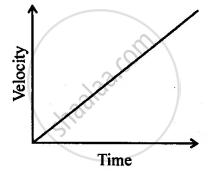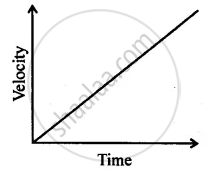Advertisements
Advertisements
Question
Can you suggest a real-life example about the motion of a body from the following velocity – time graph?

Solution

The figure shows that the car is moving with uniform acceleration. i.e. when velocity of car increases equally in equal intervals of time.
APPEARS IN
RELATED QUESTIONS
A bus decreases its speed from 80 km h−1 to 60 km h−1 in 5 s. Find the acceleration of the bus.
Name the physical quantity whose SI unit is :
(a) m/s (b) m/s2
A bus running at a speed of 18 km/h is stopped in 2.5 seconds by applying brakes. Calculate the retardation produced.
A train travelling at 20 m s-1 accelerates at 0.5 m s-2 for 30 s. How far will it travel in this time ?
Which of the following could not be a unit of acceleration?
The velocity-time graph of a body in motion is a straight line inclined to the time axis. The correct statement is ___________
Write three equations of uniformly accelerated motion relating the initial velocity (u), final velocity (v), time (t), acceleration (a) and displacement (S).
When is the negative acceleration?
How can you find the following?
Acceleration from velocity – time graph.
Two stones are thrown vertically upwards simultaneously with their initial velocities u1 and u2 respectively. Prove that the heights reached by them would be in the ratio of `"u"_1^2 : "u"_2^2` (Assume upward acceleration is –g and downward acceleration to be +g)
